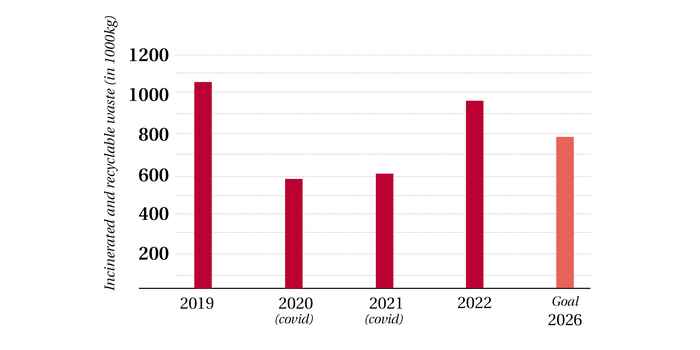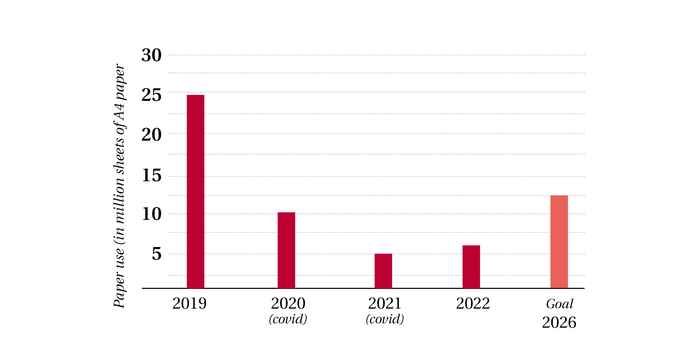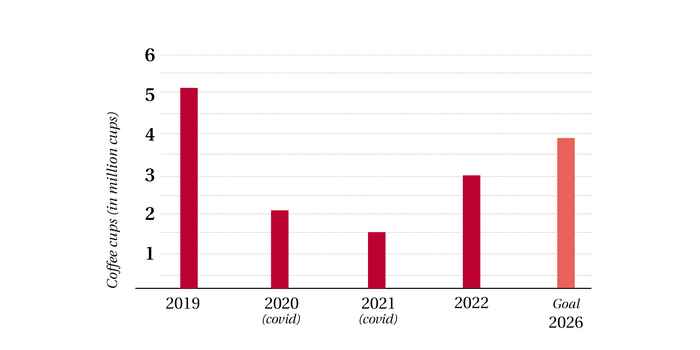Sustainable operational management: waste and procurement
Objectives and current situation
A 25% reduction of the footprint of the products and services we purchase
In 2019, we conducted a baseline measurement and found that the products and services we had purchased had a footprint of: 21,934 tonnes of CO2 equivalent. We will conduct a second measurement in 2026. In 2022, the UvA entered into a new contract with the waste management company Seenons. One of the things we have agreed with them is that they will draw up improvement plans to help us achieve this objective. In 2023, we will work on a better safeguarding of sustainability in our procurement processes.
25% reduction of raw materials consumption by 2026
We are measuring the amount of incinerated and recyclable waste to establish our progress towards this objective. In 2019, we disposed of a total of 1020 tonnes of waste. The figure for 2022 was 960 tonnes, down roughly 6% on the baseline measurement conducted in 2019. The sharp fall in 2020 and 2021 was caused by the COVID-19 pandemic. In the coming years, we will continue to work on further reducing our raw materials consumption.
We launched a system for the separate collection of waste flows in 2022. That resulted in a rise in the amount of recycled waste from 19% in 2019 to 36% in 2022.
50% reduction of paper use and number of printers at the UvA by 2026, and procurement of our own recycled paper (2026)
This is an overview of paper use based on the number of sheets of A4 paper. The sharp fall in 2020 and 2021 was caused by the COVID-19 pandemic. It is also striking that in 2022, when the UvA was fully up and running again, paper use remained a good 70% lower than in 2019. Therefore, it appears that the envisaged reduction of paper use has been achieved.
A 25% reduction of purchasing of new furniture by extending the lifespan of furniture (and, where possible, purchasing reused furniture)
No data for this objective are available at present; the UvA is exploring ways of obtaining data in relation to this in consultation with suppliers.
A 25% reduction of use of disposables (including coffee cups) by 2026
We aim to achieve a 25% reduction of the use of disposable items (including coffee cups) by 2026 compared with 2019. We used 5.1 million coffee cups in 2019. Our objective is to reduce this to 3.8 million by 2026. The sharp fall in 2020 and 2021 was caused by the COVID-19 pandemic. In 2022, the figure stood at 3.0 million coffee cups, meaning that use has fallen by about 42% compared with 2019. Staff members or students had their own cups for 11% of the drinks obtained from vending machines in 2022.
From 2023, we will remove sugar sachets, milk pots and stirrers from as many vending machines as possible.
From 2024, cups and packaging materials in the canteens will have to be reused.
The UvA has been gaining a better insight into the quantities of chemicals and cleaning products at each location since 2021.
Based on that insight, a plan will be drawn up and implemented in order, where possible, to reduce the use of the substances that cause the greatest harm to the environment and to health.
The Faculty of Science (FNWI) laboratories use the most chemicals. The impact of those chemicals, amounting to 117.8 tonnes of CO2 equivalent, has been identified for 2021. Liquid nitrogen and solvents accounted for 94% of that impact in 2021. In the years ahead, we will monitor how much liquid nitrogen and solvents are used and try to reduce that use.
375 tonnes of liquid nitrogen were used at the Faculty of Science in 2021. The figure for 2022 was 314 tonnes, a decrease of 16%. When it comes to the use of solvents, at present we only know the figure for 2021, when nine tonnes were used.
Status of other envisaged measures
Read more about the measures in the White Paper on Sustainability (PDF, 19 pages).
-
A focus on sustainability has been demonstrably effective when issuing invitations to tender with the biggest impact
In the coming period (2023-2025), we will issue invitations to tender for, among other things, furniture, printing and flowers, where sustainability will be taken into account.
-
Discontinuing sales of single-use water bottles
Sales of single-use water bottles were discontinued as of August 2021, and the number of tap water fountains has been increased. The COVID-19 measures make it difficult to determine what impact this has had on the sale of PET bottles. In total, 104,781 PET bottles were sold in 2020, with a total of 172,219 sold in 2021. In the coming year, we will find out through random sampling how much other packaging is in our waste.
A deposit has been charged for plastic PET bottles since July 2021. Random sampling in November 2021 revealed this to be an effective measure: hardly any PET bottles were found among refuse items.
-
We are promoting separation and waste production
We started a new way of separating waste in September 2022. Read more here. link toevoegen naar duurzaam afval scheiden.
-
Abolishing individual food waste containers in 2022
The launch of a collection system for separate waste flows in 2022 has seen the abolition of the use of individual food waste containers.
-
We have stopped buying new furniture when relocations take place
The aim is to take furniture that is still usable to the new location, or to use the furniture already at the new workplace.
The extent of compliance with the policy has not yet been identified.
-
We are encouraging demand for reused and recycled products
We are doing this by purchasing products we have recycled ourselves, e.g. by buying back our ‘own’ recycled paper.
-
We are driving waste reduction through our procurement processes
This applies to, among other things, packaging materials such as reusable cups and trays.
-
We are promoting waste separation and reduction
Through clear communication and smart environmental design.


